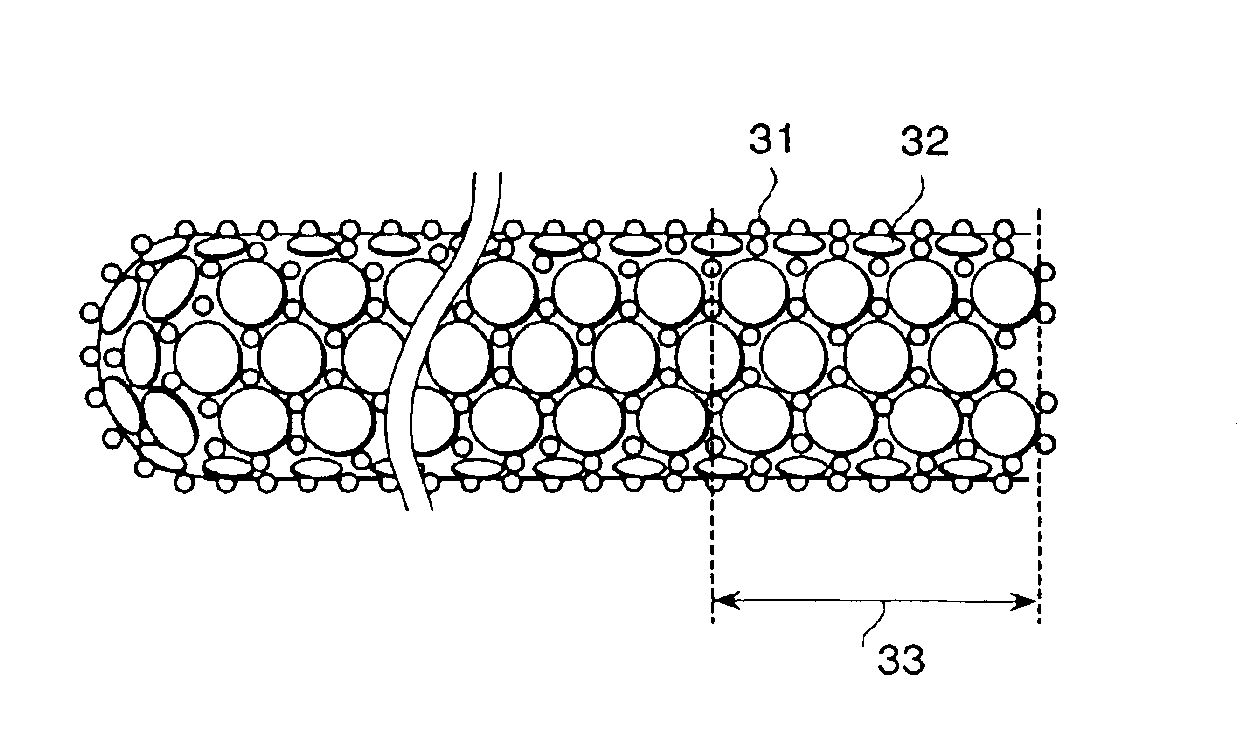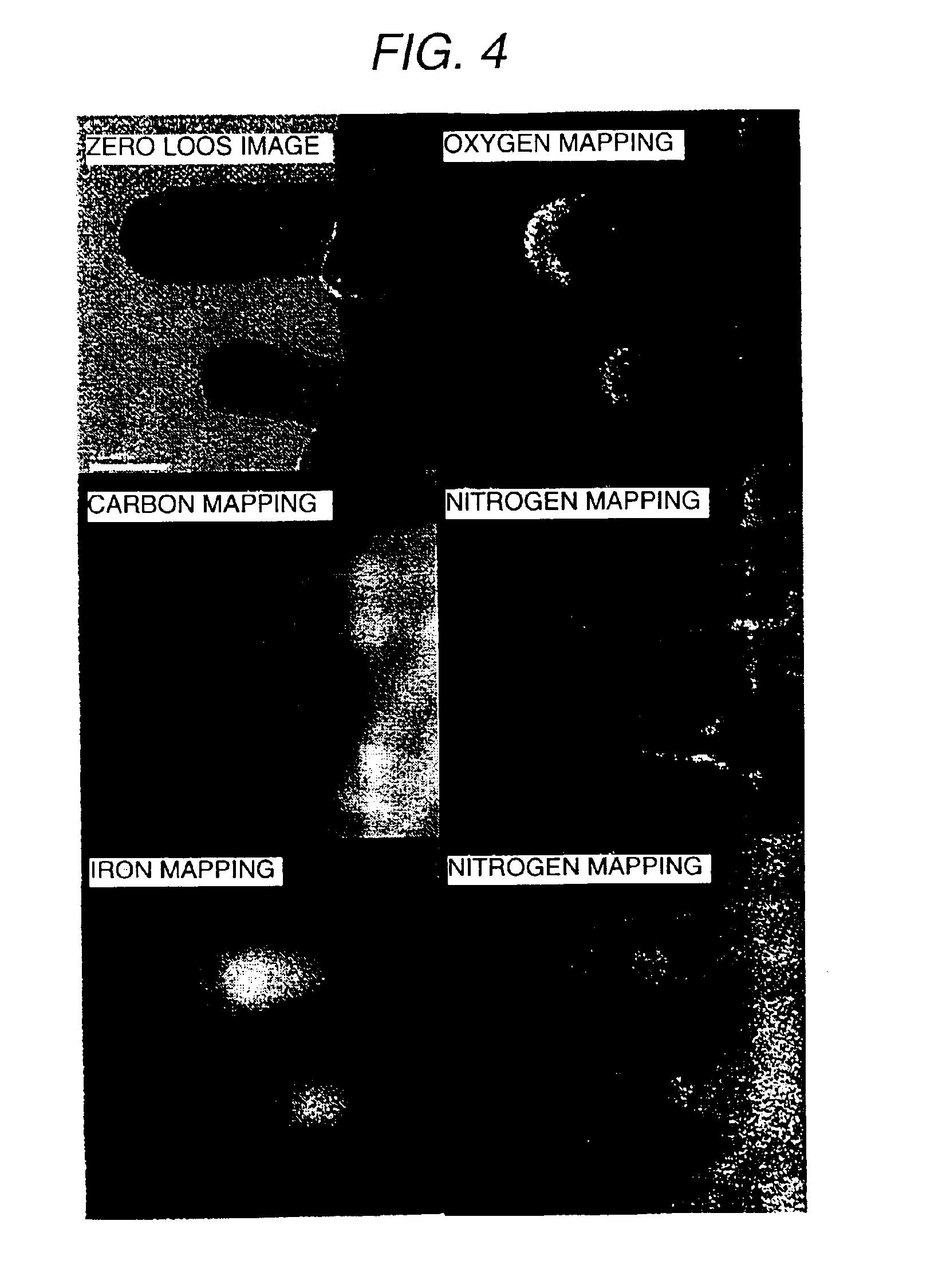Magnetic carbon nanotube
a carbon nanotube and magnetic technology, applied in the field of carbon nanotubes, can solve the problems of affecting the strength of the bond between, affecting the stability of the bond, and affecting the stability of the bond, and achieve the effect of high thermal stability
- Summary
- Abstract
- Description
- Claims
- Application Information
AI Technical Summary
Benefits of technology
Problems solved by technology
Method used
Image
Examples
embodiment 1
[Embodiment 1]
FIGS. 1 and 2 are schematic diagrams showing a carbon nanotube. FIG. 1 shows a carbon nanotube having a cylindrical shape, which is composed of a single graphite layer 11. It is referred to as a single walled carbon nanotube (SWCNT). FIG. 2 shows a carbon nanotube, having a cylindrical shape, which is composed of an outer graphite layer 21 and an inner graphite layer 22. It is referred to as a multi-walled carbon nanotube (MWCNT). Incidentally, a MWCNT includes not only those structures composed of two walls, but also those structures composed of three or more walls. In addition, some kinds of SMCNT and MWCNT have their ends covered with a semispherical cap composed of five-membered rings. Such a cap is called a “fullerene cap”.
FIG. 3 is a schematic diagram showing a carbon nanotube pertaining to the present invention. This carbon nanotube has some of its constituent carbon atoms 32 replaced by doped nitrogen atoms 31, and it possesses a carbon-nitrogen mixed region 33...
embodiment 2
[Embodiment 2]
FIG. 6 is a schematic diagram showing a magnetic force microscope whose magnetic probe 65 is the carbon nanotube represented by Embodiment 1. The magnetic force microscope is made up of a laser emitter 53, a reflecting mirror 62, an optical detector 61, a cantilever 64, and a magnetic probe 65 that is attached to the cantilever 54, said magnetic probe 65 being the carbon nanotube of Embodiment 1. Incidentally, the specimen 66 being observed under the magnetic force microscope may be heated by a heater 67, if necessary.
The following method is used to attach the carbon nanotube 65 to the cantilever 64. First, a cluster of carbon nanotubes 65 is brought into contact with the tip of the cantilever 64. The resulting assemblage is placed in a focused ion beam (FIB) apparatus. A gas containing a tungsten compound is blown toward the base of the carbon nanotube in contact with the tip of the cantilever 64 during irradiation with a gallium ion beam, so that the following reacti...
embodiment 3
[Embodiment 3]
This Embodiment demonstrates the use of a carbon nanotube (pertaining to Embodiment 1) as the main magnetic pole of a head for a vertical magnetization memory. The head, which is schematically shown in FIG. 7, has an exciter 72 to generate a magnetic field that constitutes a closed magnetic circuit passing through the carbon nanotube 71, serving as the main magnetic pole, the recording medium 70, and the auxiliary magnetic pole 73.
The head for the vertical magnetization memory has the property that its recording / reproducing characteristics depend largely on the tip size of the main magnetic pole. The tip should have as small a radius of curvature as possible. Since the carbon nanotube in this embodiment has a high aspect ratio and also exhibits ferromagnetism, it permits high-density vertical magnetization in a memory medium. A carbon nanotube without a ferromagnetic metal cap may also be used as the main magnetic pole. It has no possibility of breakage and of metal pa...
PUM
| Property | Measurement | Unit |
|---|---|---|
| Curie points | aaaaa | aaaaa |
| Curie point | aaaaa | aaaaa |
| Temperature | aaaaa | aaaaa |
Abstract
Description
Claims
Application Information
 Login to View More
Login to View More - R&D
- Intellectual Property
- Life Sciences
- Materials
- Tech Scout
- Unparalleled Data Quality
- Higher Quality Content
- 60% Fewer Hallucinations
Browse by: Latest US Patents, China's latest patents, Technical Efficacy Thesaurus, Application Domain, Technology Topic, Popular Technical Reports.
© 2025 PatSnap. All rights reserved.Legal|Privacy policy|Modern Slavery Act Transparency Statement|Sitemap|About US| Contact US: help@patsnap.com



